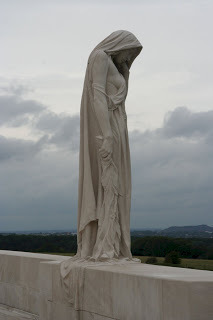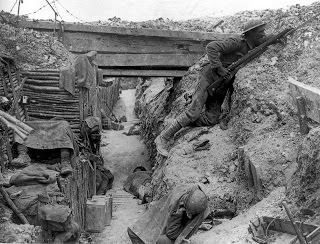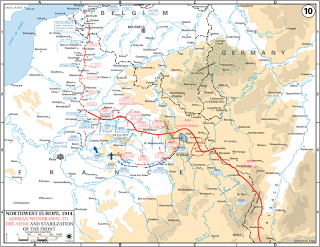Guest post from Mary Tod: Researching Is a Sleeves-Rolled-Up Process
Today Mary Tod, a historical fiction writer and fellow blogger from Canada, is stopping by with a guest essay on the many different facets to her research involving the First World War. Thanks very much, Mary, and welcome!
Researching is a sleeves-rolled-up process
 Six years ago when I began writing historical fiction, I had no idea where the journey would take me. Nor did I have any idea of how much I would enjoy the research involved. I was an expat wife, often called the trailing spouse in the world of international assignments, and I landed in Hong Kong with nothing to do. Having worked for thirty years, this was a problem.
Six years ago when I began writing historical fiction, I had no idea where the journey would take me. Nor did I have any idea of how much I would enjoy the research involved. I was an expat wife, often called the trailing spouse in the world of international assignments, and I landed in Hong Kong with nothing to do. Having worked for thirty years, this was a problem.
After many frustrating months, I decided to take matters into my own hands and write a book about my grandparents who lived through two world wars and the great depression - surely their experiences would provide the foundation for a novel, I thought. What has emerged from this vague beginning are three novels and ideas for many more. Along the way, I developed a passion for WWI and WWII and a host of research techniques and sources.
Sarah has kindly invited me to tell you a bit about the research that goes into historical fiction. Being a list making gal, I've organized my thoughts by topic:
WWW
* I have several favorite WWI websites that I frequent for information on battles, maps, timelines, photos, personalities and the tools of war. Visiting these sites allows me to adhere to reality amidst the liberty of fiction. They also spark ideas to make each story come alive.
Official War Diaries
* The Canadian government has an entire collection of official war diaries recording day to day events of every Canadian battalion. Governments can do some things right! I have spent hours poring through these pdf images looking for inspiration and accurate information. For example, my latest novel involves the heroine tracing her grandfather's WWI experiences to solve a mystery. I placed this man in the 19th Battalion of the 4th Infantry Brigade, and using the war diaries, I know exactly where he is every day of the war.
Fullbooks
* Much to my delight, I came across this site offering books of historical interest online at no cost. Of great value to me are Edith Wharton's journals describing WWI France, Mildred Aldrich's letters written from a small village near the front lines, and Charles Inman Barnard's description of Paris on the brink of war. From another site I found Ruth Gaines' vignettes of Picardy in 1918. All have been very helpful as I wrote about living with war in two of my novels.
My growing fiction and non-fiction collection
* Every time I visit my local bookstore or browse for an e-book, I look for new materials. Amongst others, my collection of non-fiction includes Vimy by Pierre Berton and Unlikely Soldiers by Jonathan Vance, the first is a detailed account of that famous WWI battle, the second is the true story of two WWII spies. Both offered deep insight into the war experience.
 * My fiction collection includes authors like Anne Perry, Ben Elton, Pat Barker, Anita Shreve, Scott Turow, Joseph Boyden, William Woodruff, Siegfried Sassoon, Frances Itani and others. Wonderful works. My copies are well thumbed and well marked.
* My fiction collection includes authors like Anne Perry, Ben Elton, Pat Barker, Anita Shreve, Scott Turow, Joseph Boyden, William Woodruff, Siegfried Sassoon, Frances Itani and others. Wonderful works. My copies are well thumbed and well marked.
Diaries and letters
* To add reality to my characters' voices, I have perused many personal accounts of war, particularly WWI, and discovered phrases and language patterns of the day. I find it both amazing and heart warming to see so many soldiers honored by their families through websites and blogs containing letters, photos and personal details. British, American, Canadian, Australian, New Zealand stories are there for all to see. If you read French or German, you can find even more diaries.
* A particularly interesting book is The Letters of Agar Adamson, a WWI captain who enlisted at the age of 48. Fascinating first hand account.
Google & Google maps
* Ah, Google. An amazing source as every reader and writer knows, a place to find tidbits like the construction of a kite or the names of troop transport ships and to stumble upon serendipity like French marriage rituals or the lions outside New York's main library.
* Using Google maps I can look at tiny villages like Villers-au-Bois or larger places like Amiens and can then check the surrounding countryside to see the contours of the land, the placement of crossroads, the bends in a river. I can then match war-time photos with present day in order to breathe life into descriptions of a picnic, a country drive, a battlefield or a behind the lines view.
Museums
* To date I've visited museums in England, Canada and France. These buildings, whether large or small, house a wealth of photos, posters, dioramas and context to augment my stories. In some cases, they include the sounds of war which are crucial to a writer's toolbox. While visiting, I've taken many pictures and notes.
Personal travel
* Last summer my husband and I traveled to northern France with the express purpose of seeing WWI battle sites and memorials as well as the lands of Picardy and Nord-Pas-de-Calais where so many battles occurred. I filled an entire notebook and came home with over five hundred pictures.

* While sitting in a cafe having dinner one night, my third novel was born. You never know what a glass or two of French wine will inspire!
Movies
* Whenever I have the opportunity to watch a movie set in either war, I do using my ever-present notebook to jot thoughts as the movie unfolds. What I look for most is sounds and visuals.
Fashion
* In addition to photos of the time, I've discovered a few fashion websites like www.fashion-era.com or www.victoriana.com or www.costumes.org. Pictures and descriptions from these sites give little snippets to use when setting a scene or introducing a character.
Sounds
* Historical radio broadcasts have also helped. Hearing a speech made by Woodrow Wilson or King Edward VIII, listening to a reporter recount the actual Dieppe landing raids or hearing songs from the past make that world come alive in a visceral manner.
I am fortunate that the world wars are relatively recent and as a consequence easier to research. Nonetheless, I often work for hours in order to write a few sentences. Good thing I enjoy the process!
Bio
Mary Tod writes historical fiction with a focus on WWI and WWII. Her novel, Lies Told in Silence is represented by Anne McDermid & Associates. While The Secret Sits is a companion novel with intersecting characters. A third novel, Blind Regret is nearing completion.
Mary posts frequently on the topics of historical fiction and the business of writing on her blog, One Writer's Voice.
Researching is a sleeves-rolled-up process
 Six years ago when I began writing historical fiction, I had no idea where the journey would take me. Nor did I have any idea of how much I would enjoy the research involved. I was an expat wife, often called the trailing spouse in the world of international assignments, and I landed in Hong Kong with nothing to do. Having worked for thirty years, this was a problem.
Six years ago when I began writing historical fiction, I had no idea where the journey would take me. Nor did I have any idea of how much I would enjoy the research involved. I was an expat wife, often called the trailing spouse in the world of international assignments, and I landed in Hong Kong with nothing to do. Having worked for thirty years, this was a problem.After many frustrating months, I decided to take matters into my own hands and write a book about my grandparents who lived through two world wars and the great depression - surely their experiences would provide the foundation for a novel, I thought. What has emerged from this vague beginning are three novels and ideas for many more. Along the way, I developed a passion for WWI and WWII and a host of research techniques and sources.
Sarah has kindly invited me to tell you a bit about the research that goes into historical fiction. Being a list making gal, I've organized my thoughts by topic:
WWW
* I have several favorite WWI websites that I frequent for information on battles, maps, timelines, photos, personalities and the tools of war. Visiting these sites allows me to adhere to reality amidst the liberty of fiction. They also spark ideas to make each story come alive.
Official War Diaries
* The Canadian government has an entire collection of official war diaries recording day to day events of every Canadian battalion. Governments can do some things right! I have spent hours poring through these pdf images looking for inspiration and accurate information. For example, my latest novel involves the heroine tracing her grandfather's WWI experiences to solve a mystery. I placed this man in the 19th Battalion of the 4th Infantry Brigade, and using the war diaries, I know exactly where he is every day of the war.
Fullbooks
* Much to my delight, I came across this site offering books of historical interest online at no cost. Of great value to me are Edith Wharton's journals describing WWI France, Mildred Aldrich's letters written from a small village near the front lines, and Charles Inman Barnard's description of Paris on the brink of war. From another site I found Ruth Gaines' vignettes of Picardy in 1918. All have been very helpful as I wrote about living with war in two of my novels.
My growing fiction and non-fiction collection
* Every time I visit my local bookstore or browse for an e-book, I look for new materials. Amongst others, my collection of non-fiction includes Vimy by Pierre Berton and Unlikely Soldiers by Jonathan Vance, the first is a detailed account of that famous WWI battle, the second is the true story of two WWII spies. Both offered deep insight into the war experience.
 * My fiction collection includes authors like Anne Perry, Ben Elton, Pat Barker, Anita Shreve, Scott Turow, Joseph Boyden, William Woodruff, Siegfried Sassoon, Frances Itani and others. Wonderful works. My copies are well thumbed and well marked.
* My fiction collection includes authors like Anne Perry, Ben Elton, Pat Barker, Anita Shreve, Scott Turow, Joseph Boyden, William Woodruff, Siegfried Sassoon, Frances Itani and others. Wonderful works. My copies are well thumbed and well marked.Diaries and letters
* To add reality to my characters' voices, I have perused many personal accounts of war, particularly WWI, and discovered phrases and language patterns of the day. I find it both amazing and heart warming to see so many soldiers honored by their families through websites and blogs containing letters, photos and personal details. British, American, Canadian, Australian, New Zealand stories are there for all to see. If you read French or German, you can find even more diaries.
* A particularly interesting book is The Letters of Agar Adamson, a WWI captain who enlisted at the age of 48. Fascinating first hand account.
Google & Google maps
* Ah, Google. An amazing source as every reader and writer knows, a place to find tidbits like the construction of a kite or the names of troop transport ships and to stumble upon serendipity like French marriage rituals or the lions outside New York's main library.
* Using Google maps I can look at tiny villages like Villers-au-Bois or larger places like Amiens and can then check the surrounding countryside to see the contours of the land, the placement of crossroads, the bends in a river. I can then match war-time photos with present day in order to breathe life into descriptions of a picnic, a country drive, a battlefield or a behind the lines view.
Museums
* To date I've visited museums in England, Canada and France. These buildings, whether large or small, house a wealth of photos, posters, dioramas and context to augment my stories. In some cases, they include the sounds of war which are crucial to a writer's toolbox. While visiting, I've taken many pictures and notes.
Personal travel
* Last summer my husband and I traveled to northern France with the express purpose of seeing WWI battle sites and memorials as well as the lands of Picardy and Nord-Pas-de-Calais where so many battles occurred. I filled an entire notebook and came home with over five hundred pictures.

* While sitting in a cafe having dinner one night, my third novel was born. You never know what a glass or two of French wine will inspire!
Movies
* Whenever I have the opportunity to watch a movie set in either war, I do using my ever-present notebook to jot thoughts as the movie unfolds. What I look for most is sounds and visuals.
Fashion
* In addition to photos of the time, I've discovered a few fashion websites like www.fashion-era.com or www.victoriana.com or www.costumes.org. Pictures and descriptions from these sites give little snippets to use when setting a scene or introducing a character.
Sounds
* Historical radio broadcasts have also helped. Hearing a speech made by Woodrow Wilson or King Edward VIII, listening to a reporter recount the actual Dieppe landing raids or hearing songs from the past make that world come alive in a visceral manner.
I am fortunate that the world wars are relatively recent and as a consequence easier to research. Nonetheless, I often work for hours in order to write a few sentences. Good thing I enjoy the process!
Bio
Mary Tod writes historical fiction with a focus on WWI and WWII. Her novel, Lies Told in Silence is represented by Anne McDermid & Associates. While The Secret Sits is a companion novel with intersecting characters. A third novel, Blind Regret is nearing completion.
Mary posts frequently on the topics of historical fiction and the business of writing on her blog, One Writer's Voice.
Published on May 25, 2011 04:00
No comments have been added yet.



